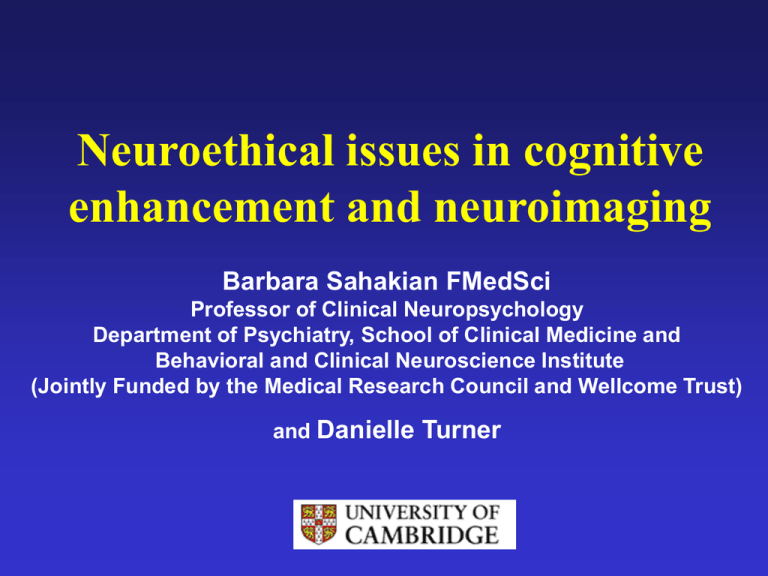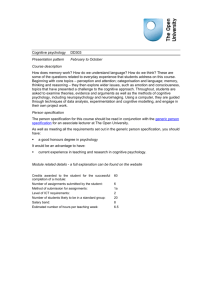
Neuroethical issues in cognitive
enhancement and neuroimaging
Barbara Sahakian FMedSci
Professor of Clinical Neuropsychology
Department of Psychiatry, School of Clinical Medicine and
Behavioral and Clinical Neuroscience Institute
(Jointly Funded by the Medical Research Council and Wellcome Trust)
and Danielle Turner
Cognitive Enhancers
• Many drugs have enormous potential to improve
the quality of life for numerous individuals and to
benefit society.
• Developments in pharmacogenomics will make it
possible to target subgroups of individuals with
safe and effective cognitive enhancers.
• It is important that we are not complacent about
the harms that many agents can cause,
particularly with long-term use and in the
developing brain.
• It is imperative to use experimental psychology
paradigms to screen drugs to ensure the safest
possible use of current and future psychotropic
drugs.
Neuroethics
The study of the ethical, legal and
social questions that arise when
scientific findings about the brain
are carried into medical practice,
legal interpretations and health
and social policy
The Dana Foundation
Marcus, 2002
Methylphenidate
Increasing prescriptions for Ritalin
Farah 2005 TICS
Modafinil
Mean attempts taken to correctly solve problem
Improvement
P=0.002
1.8
1.6
*
*
**
Placebo
Low
High
1.4
1.2
1.0
0.8
1
2
3
4
Number of moves
5
6
Modafinil improves planning in
healthy volunteers
Modafinil
100mg
Action of methylphenidate, modafinil, and atomoxetine
Methylphenidate (Ritalin) increases
synaptic concentration of Dopamine and
Noradrenaline by blocking their reuptake.
Atomoxetine (Strattera) is a relatively
selective noradrenaline reuptake inhibitor
(SNRI).
Stimulated vigilance
Modafinil (Provigil) action is unclear;
Possibilities include: indirect mediation of
ACh and/or Adrenergic alpha –1 receptor
activity. Appears to effect hypothalamic
orexin and histamine, and has a small effect
on dopamine transporter activity.
Calm wakefulness
Stahl SM (2002) J Clin Psychiatry
Novel cognitive enhancers
“40 potential cognitive enhancers are
currently in clinical development”
- NeuroInvestment
Ampakines
improve cognition
in healthy aged
volunteers
Ampakines enhance the AMPA receptor’s response to glutamate
The “Rights” and “Wrongs”
of cognitive enhancement
in healthy people
‘RIGHTS’
Potential benefits
In addition to
scientific and clinical
advances
•Increase performance (both pleasurable
and competitive activities)
– Military
– Shift workers, air traffic control …
– School pupils
• Normalisation – removal of unfair
disparity in society (if people can be helped
they should be)
Military uses of cognitive enhancers
Research and Development organisation for the US Department of Defence
“ Eliminating the need for sleep during an operation,
while maintaining the high level of both cognitive and
physical performance of the individual, will create a
fundamental change in war fighting and force
employment. Such a capability has the potential to
disrupt enemy OPTEMPO [operations tempo],
increase the effectiveness of small footprint military
forces and shorten the duration of conflict.”
‘WRONGS’
Potential harms
• There could be long-term side-effects, especially in the
developing brain
• We run the risk of becoming a homogeneous society
• There could be greater inequality, with access dependent
on wealth
• Our perception of ourselves could change (mechanistic
beings) and we will not be able to take credit for our
achievements
• Virtues such as motivation and working hard could
become outdated (students will just take a drug)
• You could be “over-enhanced” e.g. plagued by unwanted
memories
• People could be coerced into taking cognitive enhancers
(24/7 society) or even forced …
Cognitive enhancement
Conclusions
• Pharmacological enhancement is one solution to improving
society. However, we would not want to preclude other solutions,
for example, extra help in the classroom, smaller classes, greater
consideration for life/work balance etc.
• Currently cognitive enhancers (in particular pharmaceuticals like
modafinil and methylphenidate) have the potential to provide
important clinical benefits and further development in this area is
worthy of pursuit
• Pharmacogenomics will make it possible to target individuals with
safe and effective cognitive enhancers
• Scientists need to work together with social scientists,
philosophers, ethicists, policy makers and the general public to
actively discuss the ethical and moral consequences of cognitive
enhancement
• This will go some way to ensuring that technological advances are
put to maximal benefit and minimal harm
‘Brain reading’:
Ethics of neuroimaging
• Growing public perception of neuroimaging as “hard”
science, complementary to the “soft” science of
psychological evaluation
• However this new technology should be applied
cautiously – Neuroimaging is not evidence for
causation.
Example: criminal psychopaths appear to “rehabilitate”
well with behavioural therapy, yet have higher rates of
reoffending than would be predicted by their
therapists. This may be because they can manipulate
or “dupe” people, but could they “dupe” a brain scan?
News Feature, Nature 2001 vol 410: 296-298
Examples of possible
applications of neuroimaging
•
Neuroimaging of emotion in healthy
volunteers
–
–
–
•
Unconscious biases
Neural correlates of morality
Deception and lie detection
Forensic neuroimaging in violent offenders
–
–
Psychopathy and affective processing
Self-control: imaging inhibition
Unconscious racial biases
In White subjects, amygdala activation
in response to Black faces correlates
with unconscious measures of bias
(IAT response latencies)
….but not with score on Modern
Racism Scale, measuring how “racist”
they perceive themselves. (Phelps et al
J Cogn Neurosci 2000)
Would it be ethical
to screen job
applicants, judges,
lawyers, teachers,
doctors ... for
discriminatory
biases?
Neural correlates of morality
Areas shown are
those activated by
moral versus nonmoral unpleasant
visual stimuli.
Differential
activation was also
seen in moral vs.
neutral conditions.
(Moll et al J
Neurosci 2002)
How would we interpret someone’s scan that does not show
this pattern of activation. Are they immoral? Amoral?
Deception and lie detection
Differential patterns
of activation observed
for Truth (T),
spontaneous-isolated
lies (SI) and
memorized scenarios
(MS). This may be
evidence for neural
correlates of different
types of lying.
Ganis et al, Cerebral
Cortex 2003
Can we tell when someone is lying? Can we tell if someone
has a false memory?
Forensic neuroimaging: violent offenders
Criminal
psychopaths show
different patterns of
emotional-related
activity compared to
non-criminal control
subjects (Kiehl, Biol
Psychiatry 2001)
Areas of less activation
Areas of more activation
Will this change our diagnosis of “psychopathy” to a brain scan rather
than observed behaviour? Would we incarcerate “brainscanpsychopaths” before they commit a crime?
Behaviour prediction: imaging inhibition
In noncriminal male
subjects, sexual arousal in
response to erotic films
produced activation in
limbic and paralimbic
regions (compared to
viewing neutral films),
but attempted inhibition of arousal was
restricted to activation of right superior
frontal gyrus and anterior cingulate.
Beauregard et al, J Neurosci 2001
If scanning shows a lack of inhibitory ability, are you likely to commit a sexual
crime? If one’s brain cannot inhibit arousal, is one responsible for impulsive
actions? Should one be required to register with authorities or accept treatment?
Neuroethical questions
•Should we enhance cognition in healthy people and if so,
under what conditions (e.g. shift workers, military personnel
etc)?
•Should we limit access to cognitive enhancing drugs?
Fairness? Possible harms on the developing brain?
•Should we attempt to predict behaviour (e.g. the film Minority
Report)? What impact will this have on our legal system?
•What is the risk/benefit ratio to individuals and society of
using available neurotechnology? How should we address
error of measurement?
•Who should have access to this neurotechnology?
•What are the implications of developments in
pharmacogenomics?
Pharmacogenomics
Should people
who do not
experience harms
be allowed to take
illicit drugs?
Who should have
access to your
“gene chip”?
Roiser et al. Am J
Psychiatry 2005
162(3):609-612
Conclusion:
Active discourse is needed
between scientists and
ethicists, policymakers, and the
general public to address these
complicated ethical questions
raised by new neurotechnology
Neuroethics Society
http://www.neuroethicssociety.org/
Key references
•
Farah MJ, Illes J, Cook-Deegan R, Gardner H, Kandel E, King P, Parens E,
Sahakian BJ, Wolpe PR (2004) Neurocognitive enhancement: what can we
do and what should we do? Nature Reviews Neuroscience 5: 421-425
•
Turner DC, Sahakian BJ (2006) Ethical questions in functional
neuroimaging and cognitive enhancement. Poiesis and Praxis, doi:
10.1007/s10202-005-0020-1
•
Turner DC, Sahakian BJ (2006) The neuroethics of cognitive enhancement.
BioSocieties, 1: 113-123
•
Turner DC, Sahakian BJ (2006) The cognition-enhanced classroom. Better
Humans, (Eds P. Miller & J. Wilsdon), Demos
•
Duka T, Turner DC, Sahakian BJ (2005). Experimental Psychology and
research into brain science, addiction and drugs. Foresight Review.
http://www.foresight.gov.uk/Brain_Science_Addiction_and_Drugs/Reports
_and_Publications/ScienceReviews/Index.htm
See also:
• Illes, J. (Ed) (2006) Neuroethics: Defining the issues in the theory, practice
and policy, Oxford University Press
• Entire issue Brain and Cognition 50, 2002 particularly: Wolpe, Canli and
Amin






